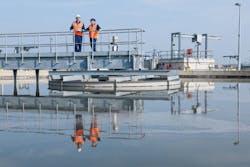Under Control Keeping Wastewater Contained
A look at how Severn Trent Water in the UK is using active monitoring to encourage early preventative action and provide data to develop a methodology for more strategic future responses.
By Steve Woods
Keeping wastewater contained within the network and preventing discharge of untreated wastewater into rivers and coastal waters - or ensuring release is within Environment Agency consents - is a priority for every water utility. This has become more pressing given the large number of exceptional weather events resulting in more frequent and prolonged discharges.
Water utilities have many challenging responsibilities. Fundamentally, they must provide high quality water supplies and sewerage services for customers, at a cost that is acceptable, while also protecting the environment, particularly river systems and bathing waters.
An optimally designed modern wastewater network will cope with all normal flow conditions. Many older sewers will also cope adequately with normal flow and rainfall. Although these were designed to allow discharge into water courses from combined sewer overflows (CSOs) at times of weather-induced exceptional flow.
Consents from the environmental regulator – the Environment Agency - only sanction these discharges under specified circumstances that are now being policed more rigorously under the requirements of the European Urban Waste Water Directive.
As part of a 'Long Term Sewer Monitoring' framework set up between utility Severn Trent Water (STW) and Detectronic, one aim is to improve network management and reduce pollution through the provision of sewer monitoring instrumentation. More recently the scope of the contract has been extended to include data analysis and interpretation.
Approaching the mid-point in the long-term contract, it is now possible to assess the effectiveness of the monitoring programme. The accumulated data now confirms the extent to which the monitoring scheme has helped STW reduce the occurrence of pollution events. Moreover, this has been achieved by not just avoiding penalties for out-of-consent discharges, but also providing the road map to more efficient future network management strategies.
Instrumentation
The technology necessary to monitor flows in wastewater networks has advanced considerably since sewer flow monitoring was first attempted almost 30 years ago. Sensors used for this partnership allow volumetric flow rate to be calculated by reference to measured depth and velocity.
Furthermore, data can now be automatically uploaded immediately if there is a high level alarm, but in normal circumstances upload is once daily via the GRPS data-network.
First generation instruments required a visit to site weekly to manually download data to a portable computer from the instruments, with subsequent manual upload into the office PC or data-network for analysis and action. This data was therefore a historic reflection of conditions.
Sometimes it could also be incomplete if a sensor had become ragged up in the interval between data downloads.
"There are many advantages in having day-by-day readings available," explains Liam Foster of STW. "This allows us to have near real-time understanding of network performance and respond promptly, often intervening at an early stage before a more serious situation develops. There is also a risk in moving from weekly to daily data that we could have been overwhelmed by an avalanche of numbers and the really significant stats, that denote sites for intervention, would not be easily identified."
Network survey and data analysis
At the outset of the contract, flow was monitored at 275 locations. During phase one Detectronic installed a further 325 of their multi-sensor flow monitors (MSFM) units. All locations track rate and depth of flow and provide a daily data upload. This goes into the STW monitoring centre and the Detectronic Data Centre (DDC) so that readings and reports can be compared.
Monitoring locations have been carefully selected and are grouped high or medium priority depending on a number of factors. These may include historic inflow and infiltration data, regulatory requirements, receiving water course classifications, known bottle necks, balance of household and industrial discharges and the density of urban development.
Analysts at the DDC review all readings from the MSFMs manually on a daily basis, reporting to Severn Trent each morning. With access to historic flow data, recent information on local weather patterns and an understanding of each location and its particular profile they are able to pinpoint potential trouble spots.
Assessing peak flows
From the data analysis, the effects of rainfall as surges pass through the drainage system are clearly seen. Likewise, the effect of temperature causing snow melt to release pent-up flow or sharp frosts that hold flow back can also be seen. These factors in turn interact with groundwater saturation levels to speed or moderate the rate at which precipitation enters the network.
For each location analysts have assessed the speed with which peak flows arise and dissipate, where the system may back-up, and what flow conditions indicate an anomaly. For example, lower rates of flow than anticipated at a given location following a significant rainfall event may indicate an upstream blockage. Conversely backing-up at a location, allied to low hydraulic velocity, are a good indicator of a downstream blockage.
Flows that continue sometime after a rain event may signify a significant level of infiltration from the ground. Flows that diminish between an upper and lower part of the network may indicate exfiltration or a more significant breach. Anomalies are an opportunity for the DDC to alert Severn Trent operations.
This enables crews to be proactive, investigating and removing blockages and conducting local system repairs. These are vital to ensure the network returns to normal performance quickly so that it is ready for the next extreme event. In other cases, monitoring provides data to justify consented discharge.
For example, if it can be shown that the network was surcharged and the maximum permitted flow is already passing through to treatment then this can be presented as evidence to the Environment Agency.
The Next Phase
Foster adds: "The process has been proven to work, identifying a number of improvements to be made at certain points in the network and producing a demonstrable reduction in reported pollution incidents since the programme started. In addition, access to the data has been useful to our asset creation teams for network modelling."
The number of monitored locations is planned to increase from the current 600 to a potential 2000.
In parallel with this, both the STW and DDC monitoring centres are developing bespoke software to assist in data filtering.
This will enable each location to be modelled more precisely so that its normal profile is more fully understood and the system can more quickly produce the exception reports that can guide proactive day-to-day maintenance and more strategic network upgrades.
Steve Woods is MD of Detectronic.
More info visit www.stwater.co.uk



